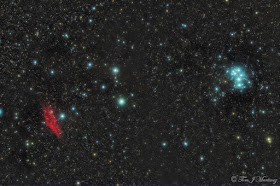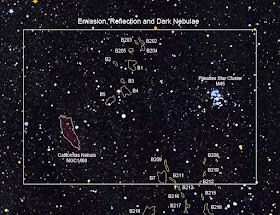 Click on image for a larger view
Click on image for a larger viewThe image you see above is a 27 second exposure of the sky from my home in Cleveland, MO using my digital Canon XTi with the lens set at 18mm (the image is cropped a bit). The bright streak is an Iridium communication satellite that increased in brightness from being almost invisible to the brightest thing in the sky, other than the Moon. Traveling from left to right at roughly 17,000 mph, it increased in brightness and diminished back to near invisibility in those 27 seconds.
Non-astronomers reading this may be wondering how I knew this was going to happen. It is actuallly pretty easy. A large group Iridium satellites, traveling around polar orbits, are used to provide satellite phone and data coverage around the world. Three door-size antennas on each satellite are highly polished and occasionally, sunlight is reflected down to Earth creating a brilliant flare lasting a few seconds. Iridium Flare prediction software has been developed so that now all one has to do is log in to the website
http://www.heavens-above.com/ , give them your location on the Earth (latitude and longitude), and you will get a set of predictions for thenext 24 hours, the next 7 days and even daytime flares for the next 7 days. Yes, you can actuallly see them in the daytime. I've even seen some accidentally while driving down the road. Here is the predication I received to get the above image. Date: 8-1-06, Time: 11:00:43, Intensity (Mag): -7, Altitude: 27 degrees, and Azimuth: 60 degrees (ENE). That's all you need.
Terminology: Time is the period when it is at its brightest.
Intensity (Mag) is how bright it will be in Magnitude. The brightest one can get is -9 Mag. The dimmest are when they are not reflecting a spot on the Earth and that is about +6 Magnitude (about as bright as the dimmest stars one can see in a dark sky. A -7 flare like in the image is bright eneough to be seen in the daytime.
Altitude is how high it is in degrees.Azimuth is the direction to face measured from due North. North is 0 degree azimuth, East is 90 degrees, South is 180, West is 270.
I do one more thing, which is not really necessary, but to precisely know where to look, I use a planetarium program on my computer. Giving it the above parameters, it will tell me what stars and constellations will be up at that time and I can see what stars it will be near so that I can center my camera to that position.
Now for some fun with BIG numbers. There is something very interesting in this image. The camera has captured objects in great depth. In the foreground you see trees that are a mere 30 feet away. The Iridium satellite is a bit farther, about 600 miles away. The stars are even further. The star, Alpheratz, the point in the cone shape constellation of Andromeda (see the picture below), is 600 light years away. In miles, that is 3,527,175,223,910,165 miles (3.5 quadrillion miles). But the camera has captured something much, much further away. This is M31, the Andromeda Galaxy (that fuzzy spot that is quite not starlike). It is 2.5 million light years from us (146,962,495,353,380,000,000,000,000,000,000 miles [146.9 nonillion miles]). Yes, nonillion is a word. It is a 1 with 30 zeros behind it.
To find M31, I first find the curved-cone shape of the brightest stars in the constellation Andromeda, then I use the three stars connected with yellow lines to point the rest of the way. You need to be away from the light pollution of the city to find it and in a moonless sky. The camera did it, however, even with the moon out.
 Click on image for a larger view
Click on image for a larger view













































